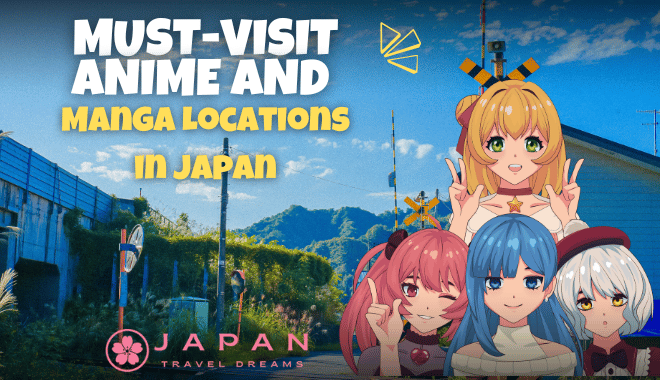Close your eyes for a second and picture this:
You’re walking down a lantern-lit street in Kyoto, the wooden machiya houses glowing softly in the evening. A faint breeze carries the scent of grilled yakitori, and you can almost hear the soundtrack from your favorite anime playing in your head.
Then you turn a corner, and—wait—isn’t that exactly the staircase from Your Name? Suddenly, you’re not just in Japan; you’re inside a story.
That’s the magic of anime and manga pilgrimages. And if you’re planning your dream trip, this guide will walk you through the Must-Visit Anime and Manga Locations in Japan, complete with detailed travel tips, local insights, and enough geeky trivia to keep your inner otaku beaming.
Why Anime & Manga Pilgrimages Are the New Big Thing

Anime and manga aren’t just entertainment in Japan — they’re cultural touchstones. They shape fashion, inspire art, and influence tourism in ways few mediums can.
For fans, visiting real-life anime locations (a practice known as seichi junrei, or “holy land pilgrimage”) has become almost a rite of passage. Why?
- It’s immersive — You’ve seen these streets, shrines, and skylines countless times in 2D. Seeing them in 3D makes the stories feel alive.
- It’s a new lens on Japan — Instead of sticking to generic tourist spots, you uncover hidden gems that locals love but guidebooks skip.
- It connects you with fellow fans — Pilgrimages draw an international crowd. You’ll meet people from all over, snapping the same scene recreations and fangirling/fanboying over the same background details.
- It supports local communities — Many small towns featured in anime experience a tourism boom, which boosts their economy and keeps traditional shops alive.
And let’s be honest — there’s something ridiculously satisfying about standing exactly where your favorite character once stood and taking that photo.
Tokyo – The Epicenter of Otaku Culture
Tokyo isn’t just Japan’s capital; it’s the beating heart of anime culture. From glitzy districts filled with themed cafés to quiet side streets that pop up in slice-of-life manga, the city is a treasure chest for fans.
Akihabara – The Electric Town
Why it’s famous: Akihabara, or “Akiba” for short, is the ultimate Must-Visit Anime and Manga Location in Japan for many travelers. Known as the Electric Town, it’s a sensory overload of anime billboards, multi-story game centers, and stores selling everything from gacha capsule toys to life-sized character cutouts.
What to do:
- Mandarake Complex – A sprawling second-hand shop where you can find rare out-of-print manga, vintage figurines, and signed merchandise.
- Animate Akihabara – The flagship store for anime goods, often featuring special pop-up events.
- Super Potato – A retro gamer’s dream, selling classic consoles and game cartridges.
- Maid Cafés – Kitsch, quirky, and uniquely Japanese, with performances, themed food, and lots of heart-shaped hand gestures.
Pro tip: Visit in the evening when the neon signs are blazing — it’s peak anime aesthetic.
Nakano Broadway – The Treasure Hunter’s Paradise
Why it’s special: Less chaotic than Akihabara but just as rich in anime culture, Nakano Broadway is a shopping complex that feels like a labyrinth of nostalgia.
Highlights:
- Multiple Mandarake stores scattered across different floors, each specializing in something — one might be all about BL manga, another might be rare model kits.
- Vintage toy shops selling items from the 70s and 80s that make collectors swoon.
- Doujinshi corners with fan-made manga, including works by now-famous artists.
Insider tip: Don’t rush. Spend an afternoon slowly exploring — you never know what hidden gem you’ll stumble upon.
Shibuya & Harajuku – Pop Culture Meets Street Style
Why it’s iconic: Shibuya Crossing — the world’s busiest intersection — has cameoed in countless anime (Tokyo Ghoul, The Devil is a Part-Timer!, Digimon). Harajuku, with its rainbow-colored crepes and out-there fashion, feels like a real-life anime street.
What to see:
- Hachiko Statue – Not just a tourist spot; it’s appeared in various anime as a meeting place.
- Takeshita Street – A fashion wonderland, perfect if your anime faves have wild street style.
Ikebukuro – Otome Road and More
Why it’s unique: While Akihabara leans male-oriented, Ikebukuro’s Otome Road caters to female fans, especially of BL and romance genres.
Don’t miss:
- Animate Ikebukuro – Another mega-store, but with a different vibe from its Akihabara cousin.
- Pokémon Center Mega Tokyo – Even if you’re not into Pokémon, the merch and displays are irresistibly cute.
Kanda Myojin Shrine – For Love Live! & Otaku Blessings
Kanda Myojin isn’t just a beautiful Shinto shrine near Akihabara — it’s also featured in Love Live! School Idol Project. The shrine has leaned into its otaku appeal, selling anime-themed charms alongside traditional ones.
Why go:
- Pray for success in studies, relationships, or even… your next gacha pull.
- Buy Love Live! ema (wooden prayer plaques) with character designs.
Insider tip: Visit during the Kanda Matsuri festival — you’ll see the streets come alive with music and color.
Odaiba – Sci-Fi and Giant Robots
Odaiba is a man-made island that feels like a futuristic anime setting — because it is. The DiverCity Tokyo Plaza hosts the full-sized Unicorn Gundam, which transforms between Unicorn and Destroy modes several times a day.
Anime connection:
- Gundam series (obviously).
- Digimon Adventure used Odaiba as the main characters’ home district.
Bonus: TeamLab Borderless (before its relocation in 2024) was basically a living anime light show.
Tokyo Tower – One Piece and Cardcaptor Sakura
The tower isn’t just a landmark — it’s featured in countless anime. Tokyo One Piece Tower was a dedicated indoor theme park until 2020, but you can still find One Piece collabs in the area. And yes, Cardcaptor Sakura fans will recognize those iconic orange-red steel beams.
Shimokitazawa – Hipster Slice-of-Life Vibes
Small vintage shops, indie cafés, and narrow streets — the exact kind of neighborhood you’d see in laid-back romance or coming-of-age anime like Tamako Market or The Great Passage.
Studio Ghibli – Pure Whimsy in Real Life
Ghibli Museum – Mitaka, Tokyo
Visiting the Ghibli Museum is like stepping into the mind of Hayao Miyazaki himself. Every detail, from the stained-glass windows to the spiral staircases, feels handcrafted to spark wonder.
Must-sees:
- The life-size Catbus (kids can climb inside — adults, sadly, cannot).
- The rooftop Robot Soldier from Laputa: Castle in the Sky.
- The exclusive short films — you won’t find them anywhere else.
Booking tip: Tickets are sold online and in advance only — set a reminder for the release date.
Ghibli Park – Aichi Prefecture
Instead of thrill rides, Ghibli Park focuses on immersion. You walk through recreated scenes, from Satsuki and Mei’s house in My Neighbor Totoro to the bustling streets of Spirited Away.
Zones:
- Hill of Youth – Inspired by Whisper of the Heart.
- Dondoko Forest – Totoro’s territory.
- Mononoke Village – Statues of boar gods and warrior huts.
Travel tip: The park is spread out — wear comfy shoes and bring water.
Real-World Anime Locations You Can Visit
Your Name (Kimi no Na wa)
Tokyo:
- Suga Shrine Staircase – The emotional climax of the film happens here.
- Shinjuku scenes – The cityscape matches the real skyline almost exactly.
Hida, Gifu:
- Hida-Furukawa Station – The exact station Mitsuha uses.
- Old town streets – Many background scenes are straight from here.
Attack on Titan – Hita City, Oita
The hometown of creator Hajime Isayama has embraced its Titan fame.
Attractions:
- Life-size statues of Eren, Mikasa, and Armin.
- An Attack on Titan Museum featuring original sketches and storyboards.
One Piece – Kumamoto & Tokyo Tower
In Kumamoto, you’ll find bronze statues of the Straw Hat crew scattered around, each tied to a different local area. Tokyo Tower’s One Piece Tower offers themed attractions, shows, and restaurants.
Slam Dunk – Kamakura
Kamakura High School’s railway crossing, with Enoshima Island in the background, is anime pilgrimage royalty.
Pro tip: Go early to avoid the constant crowd of fans recreating the opening shot.
Love Live! – Akihabara & Numazu
Numazu in Shizuoka has fully embraced Love Live! Sunshine!!, with themed cafés, merchandise, and even local trains decorated with the characters.
Kanto Region – Beyond Tokyo
Anime pilgrimages don’t stop at the Tokyo city limits.
Chichibu – Anohana’s Heartfelt Setting
The town of Chichibu in Saitama Prefecture is the backdrop for Anohana: The Flower We Saw That Day. Every major location from the anime exists here — the bridge, the shrine steps, the riverbank.
Why go:
- Chichibu Shrine and Hitsujiyama Park (beautiful pink moss fields in spring).
- Fans leave paper flowers and letters for Menma at spots featured in the anime.
Kawagoe – Little Edo Nostalgia
Its preserved Edo-period streets appear in period anime like Rurouni Kenshin or supernatural tales like Natsume’s Book of Friends.
Kyoto – The Anime Time Capsule
Kyoto blends the old and new, making it a natural setting for historical dramas and supernatural tales.
Toei Kyoto Studio Park – Step Onto an Edo Set
This working film set lets you walk through a recreated Edo-period town, complete with actors in samurai and ninja costumes. Anime like Rurouni Kenshin and Hakuouki draw from these aesthetics.
Uji – Sound! Euphonium
This riverside town south of Kyoto is the main setting for Hibike! Euphonium. Fans can visit the school, the bridge, and the tea shops that appear in the series.
Bonus: Uji is famous for matcha — you’ll find some of the best green tea desserts in Japan here.
Osaka & Kansai Anime Locations
Dotonbori – Osaka
Seen in Detective Conan and other anime, this entertainment district is perfect for night photography — the Glico Running Man sign is iconic.
Kyoto – Rurouni Kenshin & Inuyasha
Fushimi Inari Shrine’s torii gates, Gion’s geisha streets, and Arashiyama’s bamboo forest often feature in historical or supernatural anime.
Hokkaido Inspirations
Hakodate
Its European-style architecture and winter scenery give it a distinct charm, reflected in romance and slice-of-life anime.
Biei & Furano
Rolling hills, lavender fields, and pastoral beauty — perfect for anime like Silver Spoon or Anohana-esque emotional moments.
Kyushu Gems
Takachiho Gorge
Its mythological ties and dramatic landscape are often referenced in fantasy anime worlds.
Nagasaki – Barakamon’s Goto Islands
A peaceful, rural setting that mirrors the anime’s quiet charm and community spirit.
Themed Cafés & Interactive Attractions
- Pokémon Café – Adorable, themed food with table-side Pokémon visits.
- Gundam Factory Yokohama – The full-sized moving Gundam is jaw-dropping.
- Shonen Jump Stores – Everything from Naruto headbands to Demon Slayer swords.
Travel Tips for Anime & Manga Pilgrims
- Plan your route — Japan’s train system makes it easy to hit multiple anime spots in one trip.
- Respect the setting — Many scenes are from residential neighborhoods. Keep noise low.
- Look for seasonal tie-ins — Some towns host festivals or events tied to their anime fame.
- Budget for merch — You’ll want souvenirs. Trust me.
Closing Thoughts
These Must-Visit Anime and Manga Locations in Japan are more than tourist stops — they’re portals into the worlds we’ve grown up loving. Standing where your favorite character once “stood” is the closest we’ll get to crossing into those worlds, and in Japan, that’s just a train ride away.
If you’re ready to make your anime dreams real, start plotting your route. And don’t forget to pack your camera, your sense of wonder, and maybe a little extra luggage space for all the merch you’re about to buy.



